This post was co-written by AAS Digital Humanities Curator/ACLS Fellow Molly O’Hagan Hardy and AAS Head of Cataloging Alan Degutis.
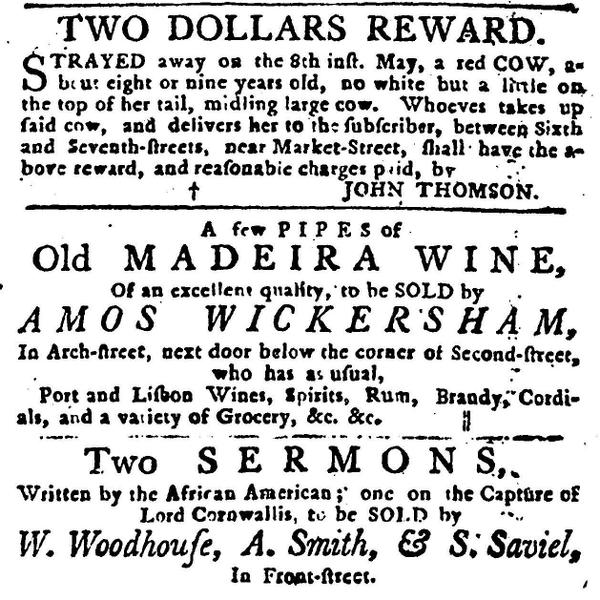 The New York Times recently reported the “discover[y]” of the earliest known use of the term “African American” from almost fifty years earlier than previously thought. The Oxford English Dictionary attributed it to The Liberator in 1835, but Fred Shapiro, an associate director at the Yale Law School Library, came across an earlier use of the term in The Pennsylvania Journal on May 15, 1782, in an advertisement for “Two Sermons, written by the African American; one on the Capture of Lord Cornwallis, to be SOLD.”
The New York Times recently reported the “discover[y]” of the earliest known use of the term “African American” from almost fifty years earlier than previously thought. The Oxford English Dictionary attributed it to The Liberator in 1835, but Fred Shapiro, an associate director at the Yale Law School Library, came across an earlier use of the term in The Pennsylvania Journal on May 15, 1782, in an advertisement for “Two Sermons, written by the African American; one on the Capture of Lord Cornwallis, to be SOLD.”
Harvard’s Houghton Library holds the only known extant copy of the pamphlet A Sermon on the Capture of Lord Cornwallis (1782) (and they have speedily digitized it in its entirety). Though AAS does not own a copy of this pamphlet, we began to wonder if it had been recorded by our North American Imprints Program (NAIP), which aims to catalog all imprints in North America before 1820. As Hardy has written about previously, NAIP includes records for items not held by the AAS, and therefore can be understood as analogous to what the English Short Title Catalog (ESTC) is for British Studies for 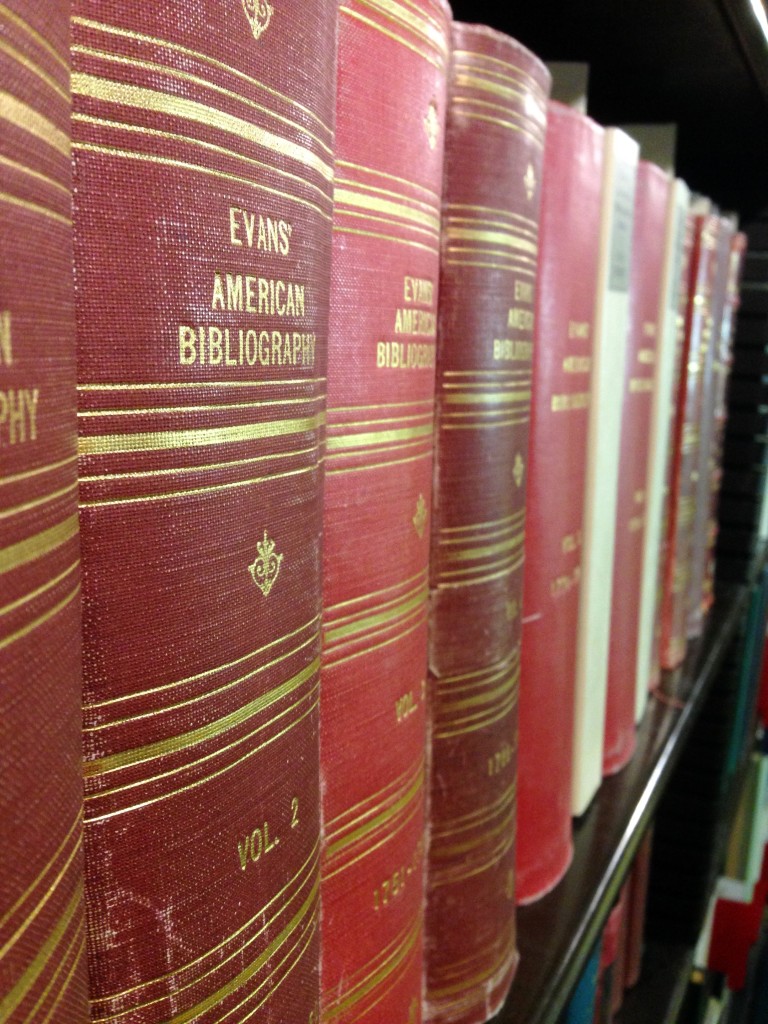 early American studies. A Sermon on the Capture of Lord Cornwallis certainly fit the NAIP criteria for inclusion: it was printed in the U.S. before 1820 and though it was not recorded in Charles Evans’s monumental twelve-volume American Bibliography, if a copy existed, NAIP ought to have a record for it.
early American studies. A Sermon on the Capture of Lord Cornwallis certainly fit the NAIP criteria for inclusion: it was printed in the U.S. before 1820 and though it was not recorded in Charles Evans’s monumental twelve-volume American Bibliography, if a copy existed, NAIP ought to have a record for it.
Before exploring the record, let us say a word about how and why such records were created. In the late 1970s the ESTC was established, with offices in London and Baton Rouge. As plans for the ESTC were being developed, Marcus McCorison, director of the American Antiquarian Society, proposed that AAS collaborate with the ESTC, taking responsibility for cataloging U.S. and Canadian imprints within ESTC scope. Thus, with the generous support of the National Endowment for the Humanities, the North American Imprints Program (NAIP) was established as a sister project to the ESTC. As work on the ESTC began, Henry Snyder, director of the North American office, began to solicit North American libraries to contribute reports of their eighteenth-century holdings. Reports could come in three forms: 1) photocopy of the title pages with bibliographic information filled out (this was the preferred form); 2) 5X7 note cards with bibliographic information filled out; 3) copy of a main entry catalog card (this was the least preferred form because the information was not standardized). Reports for North American imprints were forwarded to the NAIP office at AAS. Last week, we went down to the basement to dig up this very report, and were pleased to see that it came in the first of these three formats:
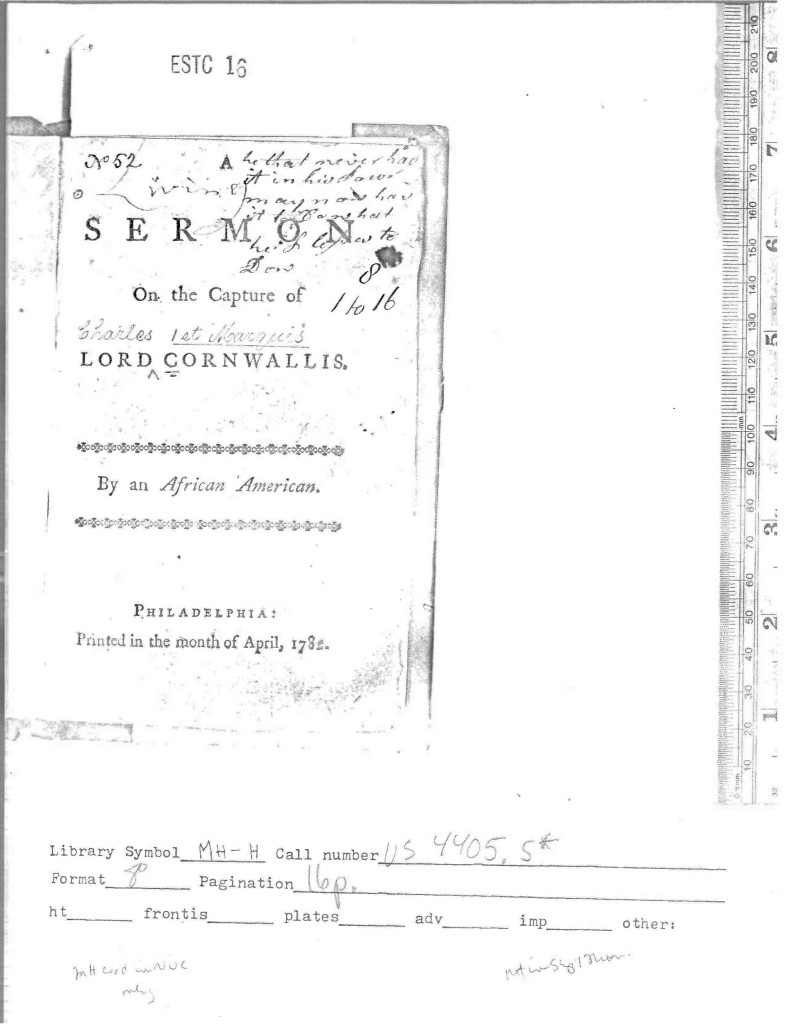 By 1985, AAS NAIP catalogers had completed the cataloging of AAS holdings, and had begun to create records from ESTC reports for North American imprints. It is at this time that the initial record for A Sermon on the Capture of Lord Cornwallis was created, with the minimal genre heading of “Sermons” in the MAchine-Readable Cataloging (MARC) 655 field.
By 1985, AAS NAIP catalogers had completed the cataloging of AAS holdings, and had begun to create records from ESTC reports for North American imprints. It is at this time that the initial record for A Sermon on the Capture of Lord Cornwallis was created, with the minimal genre heading of “Sermons” in the MAchine-Readable Cataloging (MARC) 655 field.
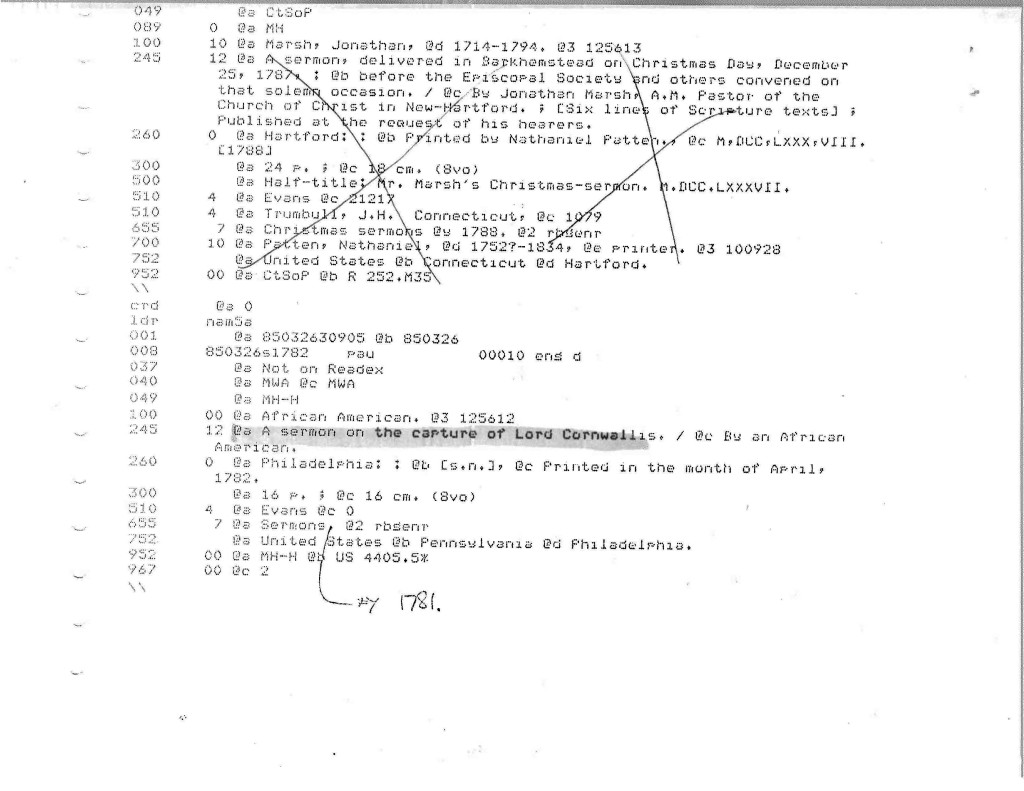
NAIP records were integrated into the ESTC file in 1990, and these records were made available through the Research Libraries Information Network (RLIN), as a microfiche catalog, as a CD-Rom catalog, and eventually in the online version of the ESTC we use today. Part of the work of NAIP was not only to create this comprehensive catalog, but also to enhance the records that AAS received with more complete metadata wherever possible. And an AAS cataloger eventually did just that by adding two subject headings. The NAIP record (below) now includes information about the content of the pamphlet. The MARC 651 field contains the subject heading Yorktown (Va.)—History—Siege, 1781. A NAIP-specific heading (“Blacks as authors”) appears in the 650 field; the heading allows researchers to search for titles written by Black authors. To the heading is added the name of the author; in this case, the author can be identified only by the phrase “an African American” found on the title page of the pamphlet.
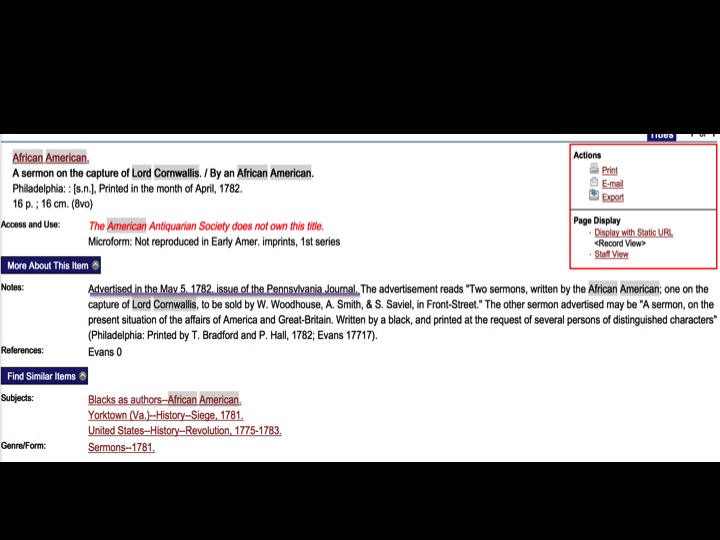 Degutis has since added a “General Note” in the 500 field with a citation to the advertisement Shapiro found in the Pennsylvania Journal. We are grateful to have this additional information in our record. This news also offers us a chance to realize once again how much crucial information is contained in the metadata of the NAIP records; it is just waiting for scholars to put that information to work as data in the role of evidence, to paraphrase Trevor Munoz’s useful definition of data. We at AAS have been dedicated to assisting such efforts for decades, and the tools and methodologies of digital humanities offers us new ways to do so.
Degutis has since added a “General Note” in the 500 field with a citation to the advertisement Shapiro found in the Pennsylvania Journal. We are grateful to have this additional information in our record. This news also offers us a chance to realize once again how much crucial information is contained in the metadata of the NAIP records; it is just waiting for scholars to put that information to work as data in the role of evidence, to paraphrase Trevor Munoz’s useful definition of data. We at AAS have been dedicated to assisting such efforts for decades, and the tools and methodologies of digital humanities offers us new ways to do so.

“in this case, the author can be identified only by the phrase “an African American” found on the title page of the pamphlet.”
The phrase “an African American” is NOT in fact found on the title page of the pamphlet – it says “the African American”. How can you quote a phrase when that phrase didn’t exist?
The title page reads “an African American.” The advertisement for the pamphlet uses the definite article “the.”